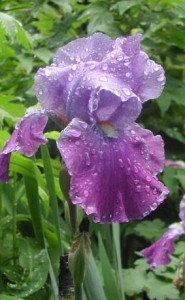Perennials – Iris
 March 28, 2012
March 28, 2012
Iris are showy perennials with beautiful blooms that takes it name from the Greek goddess of the rainbow. Not only being the scientific name, Iris is also vastly used as a common name for all iris species. Its habitats are varied and range from hot to cold climates. Iris is a perennial herb which grows from creeping rhizomes or, in drier climates from bulbs. There are several varieties available for our Minnesota climate with several different colors to choose from. They are available in different sizes and forms which can give you a succession of blooms from mid-April to early July. They bloom having long, erect flowering stems which may be single or branched, solid or hollow, and flattened or have a circular cross section.
There are a number of Irises that can bloom in our Minnesota zone 4 climate and are categorized into 4 types; crested, bulbous, beardless and bearded iris. Out of the hundreds of types of iris rhizomes available, bearded irises are spectacular, popular and eye catching when planted in our gardens. They have a very basic feature of fuzzy beards on their falls.
The bearded Irises are easy to propagate and cultivate and are becoming very popular in our perennial gardens here in Minnesota. You can choose to plant these Bearded Irises along with other annuals and other perennials in your garden. The best location for them is where the soil has a neutral pH value of 7 and is well-drained. Bearded Iris love sunny locations which helps to promote their beautiful blooms. In Minnesota and similar climates it is best to plant your Iris August. If you plant your Iris in September or later you can expect fewer blooms the following season.
When mulching your perennial and annual beds be careful to not cover the rhizomes with soil or other organic material, as this often causes the rhizomes to rot. You can use Preen which really helps these rhizomes as they do not perform well when they are surrounded with weeds.
You can also transplant iris rhizomes by placing them in a pot with soil and simply move them from one area to another. Be careful not plant them too deep, you want to be able to see the top of rhizome after planting.
It is good to divide Iris once every 3 or 4 years. Its branches spread like a fork and mature outward from the back of the fan of leaves. Use a spading fork and dig the plants gently and pull them apart at the divisions. Cut back the foliage to about six inches. Plant the rhizomes on the top of ridge of soil, keeping the rhizome partially exposed and covering the roots with soil. Be sure to examine the rhizomes before planting the irises and remove any that have rot or borers. Borers are one of the main issues the irises face. Borers start their life cycle in the form of eggs that are laid during the late fall on iris foliage and rhizomes. During the spring season, the borers start burrowing into the foliage and rhizomes developing through the summer into a gray, wormlike creature which will be one inch long. You can trace them as they start moving inside the leaves leaving traces on the leaves. At the end of summer season, these borers leave the irises and live in the soil till fall and hatch eggs which start another borer life cycle there. When your iris perennials are affected with borers, the foliage on them will have holes chewed through them.
You can use Cygon which is a proven chemical and effective treatment. If you prefer to not use chemicals you can also control borers by using beneficial nematodes. The best species of nematodes is one called Steinernema carpocapsae showing nearly 100% control of borers if it is used properly. Soil temperature needs to be above 50°F, also applying 1 quart of water per square foot so the nematodes can swim to their prey.
If you would like our help with your perennial garden project please contact us, Niwa Design Studio, at 952-470-1882.

 Posted in
Posted in  content rss
content rss